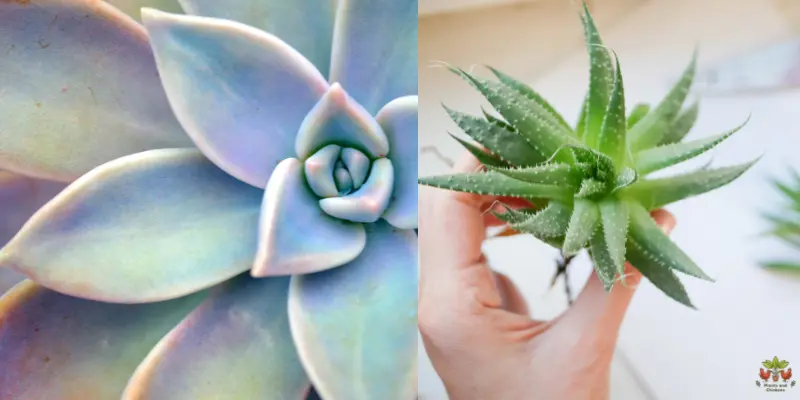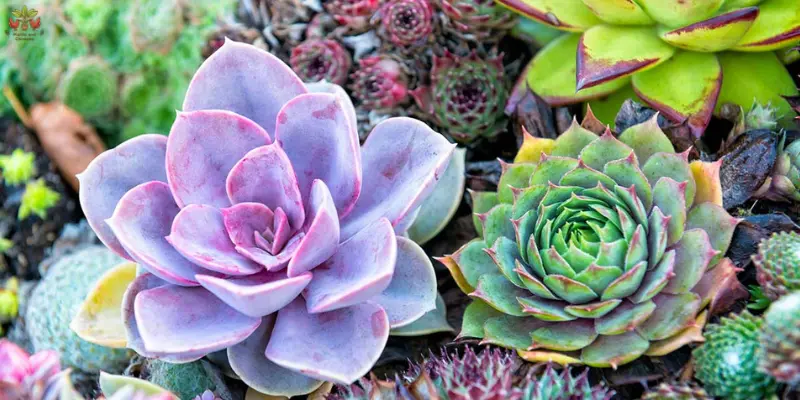Your green succulent may be turning purple due to light stress or genetics. Excessive direct sunlight or insufficient light can cause the plant to react by turning purple to protect itself.
Additionally, some succulent varieties naturally have purple or maroon leaves. Lack of proper sunlight, long-term exposure to cold temperatures, improper soil drainage, and overwatering can also contribute to the change in color. It is important to ensure that your succulent is receiving adequate light and the right amount of water to maintain its healthy green color.
Table of Contents
Reasons For Succulent Turning Purple
Green succulents can turn purple due to light stress and genetics, with some plant varieties naturally having purple leaves. Other causes include a lack of proper sunlight, exposure to cold temperatures, improper soil drainage, and overwatering. If your succulent is turning purple, it may be a sign of stress or environmental changes.
There are several reasons why your green succulent may be turning purple. Understanding these causes can help you take appropriate measures to restore your succulent’s health and beauty. Here are three common factors that contribute to succulents turning purple:
Light Stress
One possible reason for your succulent turning purple is light stress. When a plant is exposed to too much direct sunlight or insufficient light, it may start to develop a purple hue. This color change is actually a natural defense mechanism of the plant, as it tries to protect itself from the harmful effects of excess light exposure. To remedy this, you can try moving your succulent to a location with more appropriate lighting conditions or provide shade during the hottest parts of the day.
Genetics
In some cases, the purple coloration of your succulent may be due to its genetics. Certain plant varieties naturally have purple or maroon leaves. These pigments are present in the plant from the beginning and are not related to stress or environmental factors. If you have chosen a succulent with purple leaves, it’s important to note that the color change is a normal part of its growth and development.
Improper Sunlight Or Temperature Exposure
Another factor that can cause your green succulent to turn purple is improper exposure to sunlight or temperature fluctuations. Long-term exposure to cold temperatures or sudden changes in temperature can stress the plant and trigger the purple coloration. Additionally, if the succulent is not receiving adequate sunlight or is being exposed to extreme weather conditions, it may also turn purple. To prevent this, make sure to position your succulent in a location that offers the right amount of sunlight and protects it from drastic temperature changes.

Effects Of Overwatering On Succulents
When a green succulent starts turning purple, it is usually a sign of overwatering. Excess water causes the roots to rot, leading to a lack of oxygen and nutrient absorption, resulting in the plant’s leaves changing color. It is important to adjust the watering frequency and ensure proper drainage to prevent further damage.
Translucent And Discolored Leaves
An unmistakable sign of overwatering in succulents is the appearance of translucent and discolored leaves. When a succulent receives too much water, it struggles to absorb it all, resulting in excess moisture gathering in the leaves. This causes the leaves to become thin and almost see-through, losing the vibrant green color they once had. Instead, they may turn a pale yellow or even take on a purple hue. The translucency and change in color are clear indicators that the succulent is being overwatered and needs immediate attention.
Soggy Texture
Another effect of overwatering in succulents is a change in texture. Typically, succulent leaves have a firm and plump feel. However, when overwatered, they become soft and mushy. The excess water fills the leaves, causing them to swell and lose their natural crispness. Running your fingers along the leaves of an overwatered succulent will reveal a soggy texture that signals the need for proper drainage and a break from excessive watering.
Easy Leaf Loss
Overwatered succulents are prone to easy leaf loss. The excess moisture weakens the leaves, making them more susceptible to falling off. If you notice leaves dropping off your green succulent with little to no effort, it’s a telltale sign of overwatering. The weakened leaves struggle to stay attached to the plant, ultimately resulting in leaf loss. This can be alarming for succulent owners, but by addressing the issue promptly and adjusting the watering routine, the succulent can recover and regain its healthy foliage.
Tips For Maintaining Healthy Succulents
Proper Watering Techniques
Succulents require a unique watering approach to thrive. Overwatering can lead to root rot or mold, while underwatering can cause the leaves to shrivel and dry out. Here are some tips for watering your succulents:
- Only water your succulents when the top inch of soil is dry. Stick your finger into the soil to check for moisture.
- When watering, make sure to thoroughly saturate the soil until water drains out of the bottom of the pot.
- Never let your succulents sit in standing water, as this can lead to root rot. Discard any excess water.
- In winter or during dormant periods, reduce watering frequency as succulents need less water during these times.
Providing Adequate Sunlight
Succulents are sun-loving plants and require plenty of sunlight to maintain their vibrant colors. Here’s how to ensure your succulents get adequate sunlight:
- Place your succulents in a location that receives at least six hours of bright, indirect sunlight each day.
- Avoid exposing your succulents to intense, direct sunlight as this can cause sunburn and discoloration. Gradually acclimate them to direct sun if needed.
- If you’re growing succulents indoors, place them near a south-facing window or provide artificial grow lights to mimic natural sunlight.
Ensuring Proper Soil Drainage
Succulents thrive in well-draining soil that allows excess water to escape quickly. Here’s how to ensure proper soil drainage for your succulents:
By following these tips for watering, sunlight, and soil drainage, you can ensure that your succulents stay healthy and vibrant, preventing issues like purple discoloration. Remember, understanding the specific needs of your succulents is key to maintaining their optimal health.
Frequently Asked Questions Of Why Is My Green Succulent Turning Purple
Why Is My Succulent Changing Colors?
Succulents change colors when stressed due to sudden changes in watering, sunlight, or temperature. They might turn purple if exposed to too much direct sunlight or insufficient light. Certain plant varieties naturally have purple or maroon leaves. Lack of proper sunlight, long-term exposure to cold temperatures, improper soil drainage, or overwatering can also cause color changes.
What Does An Overwatered Succulent Look Like?
An overwatered succulent looks translucent, yellow, soggy to the touch, and the leaves may fall off easily. It is a reaction to excessive watering and can cause damage to the plant.
Why Is My Plant Turning Purple?
A plant may turn purple due to light stress from excessive direct sunlight or inadequate light. Some plant varieties naturally have purple leaves due to genetics. Other reasons include lack of proper sunlight, exposure to cold temperatures, improper soil drainage, and overwatering.
The plant may be stressed or reacting to sudden changes in watering, sunlight, or temperature.
Why Are My Green Succulents Turning Pink?
Green succulents can turn pink due to exposure to extreme weather conditions or under-watering. It is their way of reacting to sudden changes in watering, sunlight, or temperature. Proper sunlight, soil drainage, and watering are important to prevent color change.
Conclusion
If your green succulent is turning purple, it may be due to light stress or genetics. Excessive exposure to sunlight or insufficient light can cause the plant to turn purple as a protective measure. Some plant varieties naturally have purple leaves.
Additionally, factors like lack of proper sunlight, cold temperatures, improper soil drainage, or overwatering can also contribute to the color change. Understanding the reasons behind the purple transformation can help you address the issue and ensure the health of your succulent.


![Terrifying Trend: Why Do Roosters Chase Humans? [2024]](https://plantsandchickens.com/wp-content/uploads/2024/02/why-do-roosters-chase-humans-4.webp)


Leave a Reply